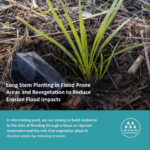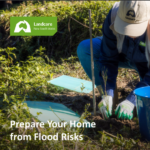Nature’s Role in Mitigating Flood Risks
Floods and erosion are interrelated environmental hazards that can have devastating impacts on landscapes, infrastructure, and communities. Understanding their dynamics and implementing nature-based interventions can mitigate these effects and promote ecological balance and resilience.
Historically, Australia relied heavily on structural measures like levees and dams for flood management. However, there’s been a shift towards nature-based solutions in recent years.
The United Nations Environment Assembly (UNEA) defines nature-based solutions as actions that protect, conserve, restore, and manage ecosystems to address social, economic, and environmental challenges. In New South Wales, Landcare focuses on nature-based solutions such as riparian revegetation to manage runoff, reduce flood risk, and promote the protection and restoration of riverine ecosystems.
Understanding Floods
Understanding the different types and impacts of floods is essential for effective prevention and mitigation. Floods can originate from various sources and cause extensive environmental and economic damage. There are several types of floods:
Riverine Flooding: Occurs when watercourses like lakes, rivers, and dams overflow onto nearby land. This is the most common type in Australia.
Flash Flooding: Caused by intense local rain, often in urban areas where water rapidly runs off roofs and concrete surfaces.
Estuarine Flooding: Happens in estuaries where freshwater and saltwater mix, influenced by both coastal and riverine factors.
Coastal Flooding and Erosion: Triggered by ocean influences like high tides, storm surges, and large waves, with ‘king tides’ causing minor flooding in low-lying areas.
Flooding is complex, caused by factors including:
- Heavy rainfall from severe thunderstorms, tropical cyclones, monsoon rain, low-pressure systems, and cold fronts, which can cause flooding far from the rainfall source.
- River capacity being exceeded by runoff from heavy rainfall.
- High soil moisture levels preventing rain from soaking into the ground.
- Water management practices, such as reservoir releases.
- Land-use changes, such as building and paving locations.
Risk Assessment and Planning
Identifying high-risk areas and developing comprehensive plans for risk mitigation is crucial in planning for floods on your property.
NSW Local Land Services – has created a farm flood readiness kit, which includes a worksheet to assess your risks by looking at your risk factors.
Problems/Impacts caused by Floods and Erosion on Landcare Activities
Environmental and Economic Damage: Floods can lead to soil erosion, crop destruction, water contamination, infrastructure damage, biodiversity loss, significant property damage, loss of life, service disruptions, long-term economic impacts, water pollution, and habitat destruction.
Erosion: One of the significant consequences of flooding is erosion, which affects agricultural productivity and ecosystem stability.
- Floods strip topsoil from agricultural lands, reducing soil fertility and degrading land productivity.
- Significant riverbank erosion, especially with limited vegetation to stabilise soil.
- Reduced agricultural productivity
- Sedimentation of waterways, affecting aquatic ecosystems (silting of downstream waterways)
- Increased vulnerability to future floods
- Poor water quality
- Deepening and widening of gullies
Erosion is accelerated when there’s little or no vegetation on or near streambanks to stabilise the soil. Pasture grass alone offers minimal protection during floods, leading to rapid loss of riverbank integrity. As soil erodes and banks steepen, the soil that’s not held in place by a variety of roots erodes quickly during a flood event.
Downloadable flood training pack and worksheet


Long Stem Planting in Flood Prone Areas and Revegetation to Reduce Erosion Flood Impacts
In this training pack, we are aiming to build resilience to the risks of flooding through a focus on riparian restoration and the role that vegetation plays in riparian zones by reducing erosion.
Download: Floods Training Pack
Prepare Your Home from Flood Risks Worksheet
Your proactive steps can significantly reduce the impact of floods on your property. Use this worksheet to guide you. Good planning is one of the best ways to set your project up for success.
Download: Flood Worksheet
Flood Videos
Join us in this hands-on guide as we take you through the process of planting long-stemmed trees along the beautiful Shoalhaven River. Watch our detailed step-by-step video to learn the best practices for planting trees and contributing to environmental conservation.
Other Disaster Resources
Helpful Resources
Managing Erosion
Local Land Services – Managing Erosion Before & After Floods
Riparian Restoration
NSW Government – Good Practices in Riparian Rehabilitation
Sustainable Farms – Riparian Restoration
Soil Conservation Service – Case Study: Post flood riparian rehabilitation on the Tweed River
Rivers of Carbon – How Restoring Rivers Builds Flood Resilience
Great Rivers Greenway – Recommendations for Stream-bank Planting
Fencing, Land Works & Healthy Soil
Stock & Waterways – Riparian Fencing
Bellinger Landcare – The Bellinger River system Landholder Booklet
Soil Conservation Service – Post flood Riparian Rehabilitation on the Tweed River
Risk Frontiers – Nature-based Flood Mitigation Strategies
Local Land Service – What is a Healthy Soil?
Shoalhaven Riverwatch – Sand Sausages on the Shoalhaven River